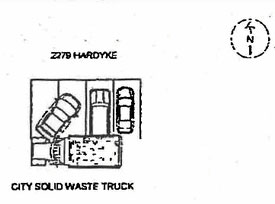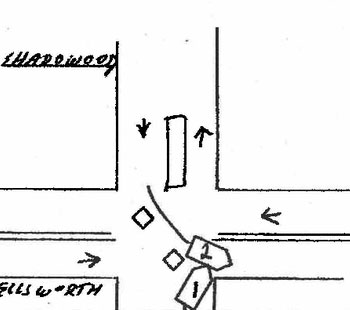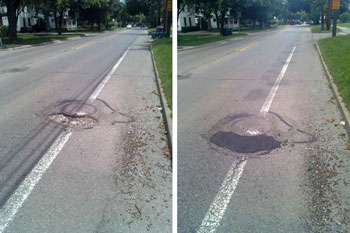Man Fights City, Settles Pothole Damage Claim
Almost exactly one year ago, on the rainy evening of Feb. 17, 2011, Chronicle reader Matt Hampel filed a 13-word Stopped.Watched. item about pavement problems on Huron Street: “Looks like southern lane of Huron west of Seventh has buckled. Police, flares.”

Is Ann Arbor the kind of city where even the potholes are heart-shaped? (Photo illustration by The Chronicle.)
A visit to the scene by The Chronicle found city crews wrapping up their work, filling in some potholes in both the eastbound and westbound lanes.
Unknown to The Chronicle at the time, another reader, Eric Wucherer, had encountered the potholed pavement on Huron Street that same evening, sustaining two flat tires.
And Wucherer was not the only driver to sustain vehicle damage due to the same set of potholes. As he described it in the web-based service request that he logged near midnight: “Pulled over behind someone with a flat tire from the same pothole, who was able to deploy their spare tire. With 2 flats, I got towed …”
Over the next few months, Wucherer filed a request under the Freedom of Information Act to obtain records of complaints made about potholes at that location. He filed a claim with the city’s board of insurance administration – it was denied. He filed an appeal of the denial – it was rejected.
Then Wucherer did something at that point in the process that no one else has tried in assistant city attorney Bob West’s recollection over the last 16 years: Wucherer filed against the city of Ann Arbor in the small claims division of the 15th District Court.
Under Act 236 of 1961, attorneys aren’t allowed to argue on behalf of clients in small claims court. But defendants in small claims court – in this case, the city of Ann Arbor – are allowed to demand that the case be removed from small claims to the general civil docket. And the city of Ann Arbor exercised its right to do that. That permitted West to handle the case.
The case was set up for West to argue, among other things, a standard governmental immunity defense on behalf of the city. But before Wucherer and West squared off – in a case that had been assigned to be heard by then-judge Julie Creal – the city offered to settle the claim.
And on Sept. 22, 2011 the city’s board of insurance administration authorized a settlement with Wucherer for $568.16. In his claim he’d asked for $750 to cover damage to tires, wheels and an axle.
In reporting this article, The Chronicle reviewed nearly a year’s worth of vehicle damage claims brought before the board of insurance administration. They included a range of vehicle damage – allegedly caused by potholes, garbage trucks, a police car, or falling tree branches.
After the jump we take a brief look at the defense the city would have made in court in the Wucherer pothole case, and the way the city approaches pothole repair, as well as some of the other types of vehicle damage claims.
Range of Vehicle Damage Claims
Under Michigan’s Freedom of Information Act (FOIA) The Chronicle requested documents related to 34 claims brought before the city’s board of insurance administration. The board handles all claims, not just those related to vehicle damage. But all 34 claims targeted by The Chronicle’s request were vehicle damage claims of some kind. We had identified them as such from the board’s meeting minutes that were attached to the city council’s meeting agendas from January 2011 through October 2011.

Diagram from accident report involving a city of Ann Arbor garbage truck that slid on an ice-covered parking lot. (Image links to complete report.)
By way of background, under the city’s ordinance, the board is supposed to consist of two city councilmembers and the city treasurer as an ex-officio member. In actual practice, the city council appears to have appointed just one member to serve on the board for the last several years. This past November that was Tony Derezinski (Ward 2).
The two largest categories of claims we reviewed were collision claims and pothole claims. Of the 34 claims we looked at, 12 were collision-type claims and 13 were pothole-type claims. Another three claims involved branches of trees in the right-of-way falling on cars. Except for Wucherer’s pothole claim, only those claims where some human agent of the city of Ann Arbor was actively involved in the incident were approved by the board. (And not all of those were approved.)
For example, the city granted claims involving the automatic arm that is used by drivers of city garbage trucks to empty the carts into the truck. If the arm is not fully retracted before the truck moves forward, the arm can do substantial damage to a vehicle in its path.
Standard operating procedure for drivers is to retract the arm before moving forward. But execution of that procedure is not perfect. As one driver states in the report that must be filled out after these incidents: “… hit car with arm that was not fully retracted, but thought it was.”

Diagram showing a police car (vehicle 1) colliding with a car turning left on a green light (vehicle 2). (Image links to complete report.)
The remedy noted is straightforward – make sure that the arm is in the “home position” before moving forward. In one report, a supervisor’s note suggests the possibility of implementing an alarm or a light to signal drivers when they’re moving forward with the arm not in the home position.
The city also granted a claim about a garbage truck that slid sideways on an ice-covered parking lot and struck three parked cars. And the city granted a claim involving a snowplow that got too close to a parked vehicle, damaging the parked vehicle’s tire. The remedy recorded in the supervisor’s note is straightforward: “Don’t get close to cars.”
The city also paid a claim involving a police car that attempted to make a right-on-red turn, and collided with a car that was turning left on a green light.
For all the claims paid by the city in the set of documents The Chronicle examined, the total approved by the city for payment came to around $22,000.
Governmental Immunity Act
In answering Wucherer’s complaint to the 15th District Court, the city argued among other things that the incident causing damage to Wucherer’s car was due to his “own lack of due care given the attendant circumstances, available information, and prior knowledge and notice.” But the key part of the city’s defense as expressed in the city’s answer to Wucherer’s complaint was reliance on governmental immunity.
Governmental Immunity Act: Background
Under Act 170 of 1964 (known by the popular name “Governmental Immunity Act”) it’s not sufficient to show that vehicle damage resulted from a specific pothole in order for the city of Ann Arbor to be legally liable for the damage. The statute makes clear that the city has to have known or should have known about the pothole and had reasonable opportunity to repair it, in order for the city to incur liability:
691.1403 Defective highways; knowledge of defect, repair.
Sec. 3.
No governmental agency is liable for injuries or damages caused by defective highways unless the governmental agency knew, or in the exercise of reasonable diligence should have known, of the existence of the defect and had a reasonable time to repair the defect before the injury took place. …
The city has mechanisms in place for finding out about potholes – beyond when city workers observe defects in pavement in the course of systematic inspection or through happenstance.

Pothole (left) was reported via the phone number 99-HOLES at 2:22 p.m. on June 14, 2011. Repaired pothole (right) observed at 1:42 p.m. on June 15. View is eastbound on West Liberty near Eighth Street.
Residents have at least two ways they can notify the city about potholes. One is a telephone number 99-HOLES (994-6537) and another is an Internet-based reporting interface.
In its response to Wucherer’s suit, the city contends that in general, it repairs potholes in a timely way. In a Stopped.Watched. item filed on June 15, 2011, The Chronicle noted a less-than-24-hour response time for the 99-HOLES number.
A variety of factors can influence response time to pothole reports. A night crew recently made its way through the same Old West Side neighborhood, and a resident speculated that it had been in response to a notification he’d sent in – two months earlier.
Governmental Immunity: Wucherer’s Case
Of the pothole claims The Chronicle reviewed, 11 of the 12 were denied by the board of insurance administration. It appears routine that the city denies such claims. None of the claimants besides Wucherer took the step of filing with the small claims division of the 15th District Court. But it’s unlikely that the city of Ann Arbor would settle a claim just because Wucherer went to the trouble to file it.
So what was it about his case that gave him at least a shot at prevailing over a standard governmental immunity defense? He would need to show that the city knew about the pothole that caused damage to his car and a reasonably adequate time to effect a repair, and failed to do so.
Wucherer had obtained through a Freedom of Information Act request the service requests from citizens made about potholes in the area. On the day of Wucherer’s incident, city’s records show a half dozen reports about potholes at least in the general vicinity of the right westbound lane of Huron Street, just west of Seventh Street, where his incident occurred, including Wucherer’s own request. It’s possible to imagine people arguing about whether a pothole report just before noon should reasonably be expected to be repaired later that evening.
To the extent there are earlier reports, those arguments would tend to tilt in the plaintiff’s direction. And the city’s records also show reports on Feb. 16, the day before Wucherer’s incident, as well as one on Feb. 14, about potholes that are at least somewhere in the general vicinity of his incident.
So for those earlier reports, it’s possible to imagine people arguing about what specific pothole prompted a report. Was it that specific pothole that caused Wucherer’s vehicle damage? Or if not, would “reasonable diligence” to repair the identified pothole have led a repair crew almost certainly to discover the pothole that caused the damage and to repair that one, too?
For example, the Feb. 14 report describes a location of “200 feet west of the Jackson/W. Huron split in the right lane westbound.” If by “split” the caller meant the “Y” in the road where Huron divides into Jackson Road and Dexter-Ann Arbor Road, then that might be far enough from Wucherer’s incident to argue that the call was not about Wucherer’s pothole at all.
According to city records, the caller on Feb. 14 described the location as “on W Huron near YMCA near S Seventh going Westbound.” Except for the reference to the YMCA, which is a quarter-mile east of that intersection, that location appears close enough to argue about.
So Wucherer had the raw material with which he could at least make some kind of argument that the city knew about or should have known about the pothole that caused damage to his car, and that the city could have reasonably been expected to repair it before his incident. And the fact that he had some kind of argument likely had an impact on the city’s willingness to settle the case.
Timeline Overview
Here’s a timeline overview of some key dates related to Wucherer’s case. [.pdf of more detailed timeline of Wucherer's case as it was processed through small claims and removed to the general civil docket.]
- 1824 First use of asphalt blocks in a road – on the Champs-Elysees in Paris. Also the year Ann Arbor is founded.
- 2011-Feb-14 Valentine’s Day, and date of one pothole report on West Huron.
- 2011-Feb-17 Wucherer drives through pothole west of Seventh on West Huron.
- 2011-Mar-24 Board of insurance administration denies Wucherer claim.
- 2011-Apr-28 Board of insurance administration denies Wucherer appeal.
- 2011-Jun-15 Wucherer files with small claims division of 15th District Court.
- 2011-Jun-27 Claim removed from small claims to general civil docket.
- 2011-Sep-22 Board of insurance administration approves settlement.
- 2011-Oct-24 City sends check to Wucherer for $568.16.
The Chronicle could not survive without regular voluntary subscriptions to support our coverage of public bodies like the city of Ann Arbor. Click this link for details: Subscribe to The Chronicle. And if you’re already supporting us, please encourage your friends, neighbors and colleagues to help support The Chronicle, too!




Good legal analysis.
More citizens should fight City Hall with FOIA requests and claims in Small Claims court to collect for vehicle damage.
It would lead to greater municipal accountability.
I made a heart shaped pizza last night; it was way yummier than that pothole :) That is pretty cool though!
And yes, small claims court is one of the great equalizers!
This is exactly the spot where on a rainy night I landed in this pothole and had a flat tire plus a bent rim. Almost $300 worth of damage. It happened several years ago, but since the area has not been resurfaced the very same hole will appear over and over again. Of course, I wasn’t smart enough to fight city hall in small claims court.
I’m surprised your timeline doesn’t include the 1909 paving of Woodward from Six Mile to Seven Mile, the first mile of concrete paving in the US. I suppose that’s because this story is about asphalt paving, not concrete.
A 1974 Ann Arbor News clipping: [link]
“Ann Arbor apparently can be held liable for damage done to vehicles and persons because of ill kept roads. City Council has learned in a memo from Assistant City Attorney John K. Vanderloon that the city “has a duty to keep its streets in reasonable repair so that they are reasonably safe for public travel.” However, Vanderloon added, there is no liability unless the city knew of the defects and had a reasonable time to correct them. Notice of injury or damage’ must also be served within 120 days of the injury. The memo was in response to a question from Councilwoman Carol Jones, D-Second Ward. Responding to the memo, Jones asked the attorney’s office to define what was meant by fixing defects in a “reasonable” time limit.
The 99-HOLES number dates from 1975: [link]
To help the city lócate the biggest holes in the streets, (Mayor James E.) Stephenson said a special telephone number is being set up for residents to cali in the locations. That number, beginning Jan. 20, is “99-HOLES.”
I’ve been surprised by how quickly West Huron Street has fallen apart. The right lanes going both ways just seemed to disintegrate. I wonder if the surfacing work was done properly.
re #7: Seems that is what happens when you have the lowest bidder build a truck highway through an area that geographically wants to be a swamp.